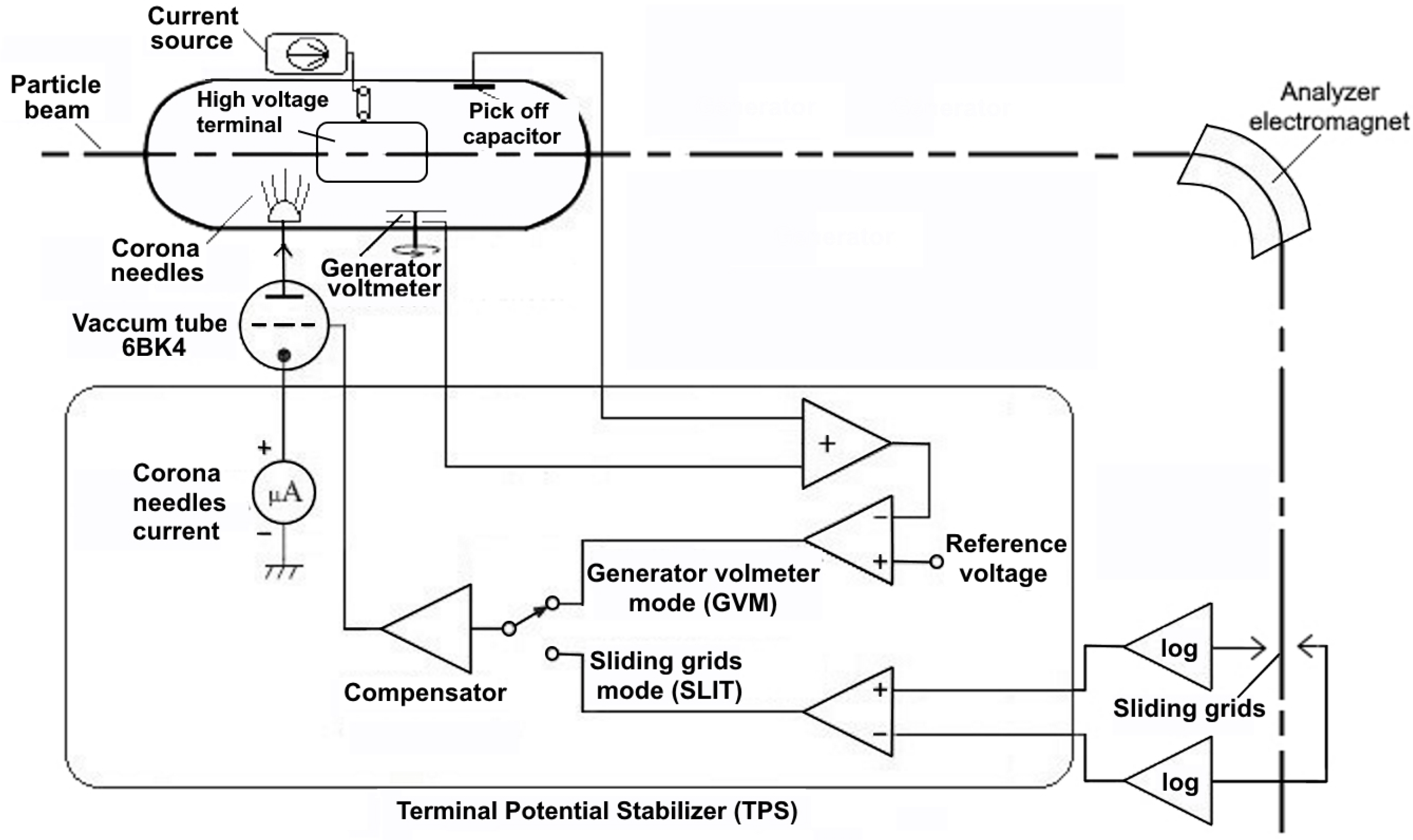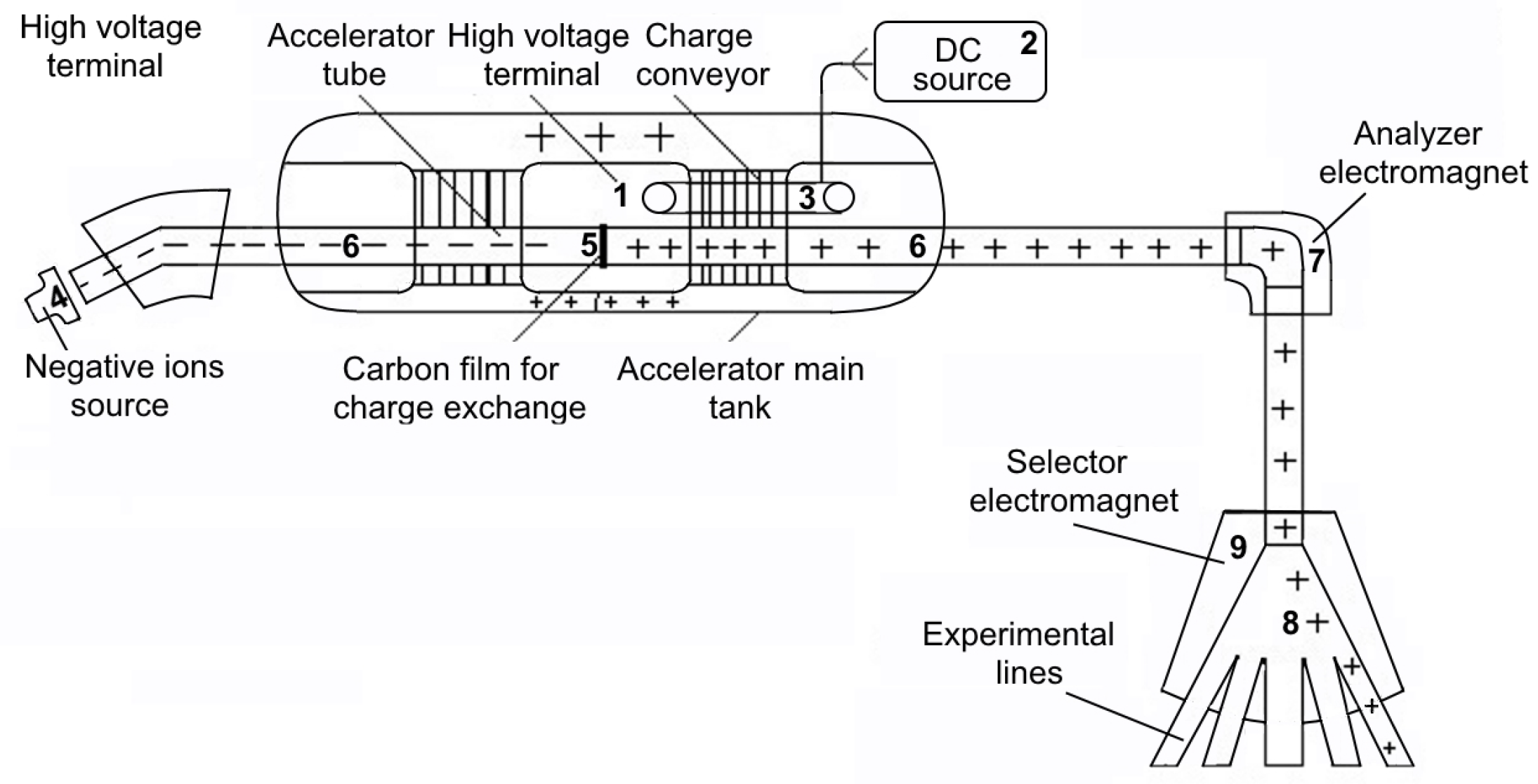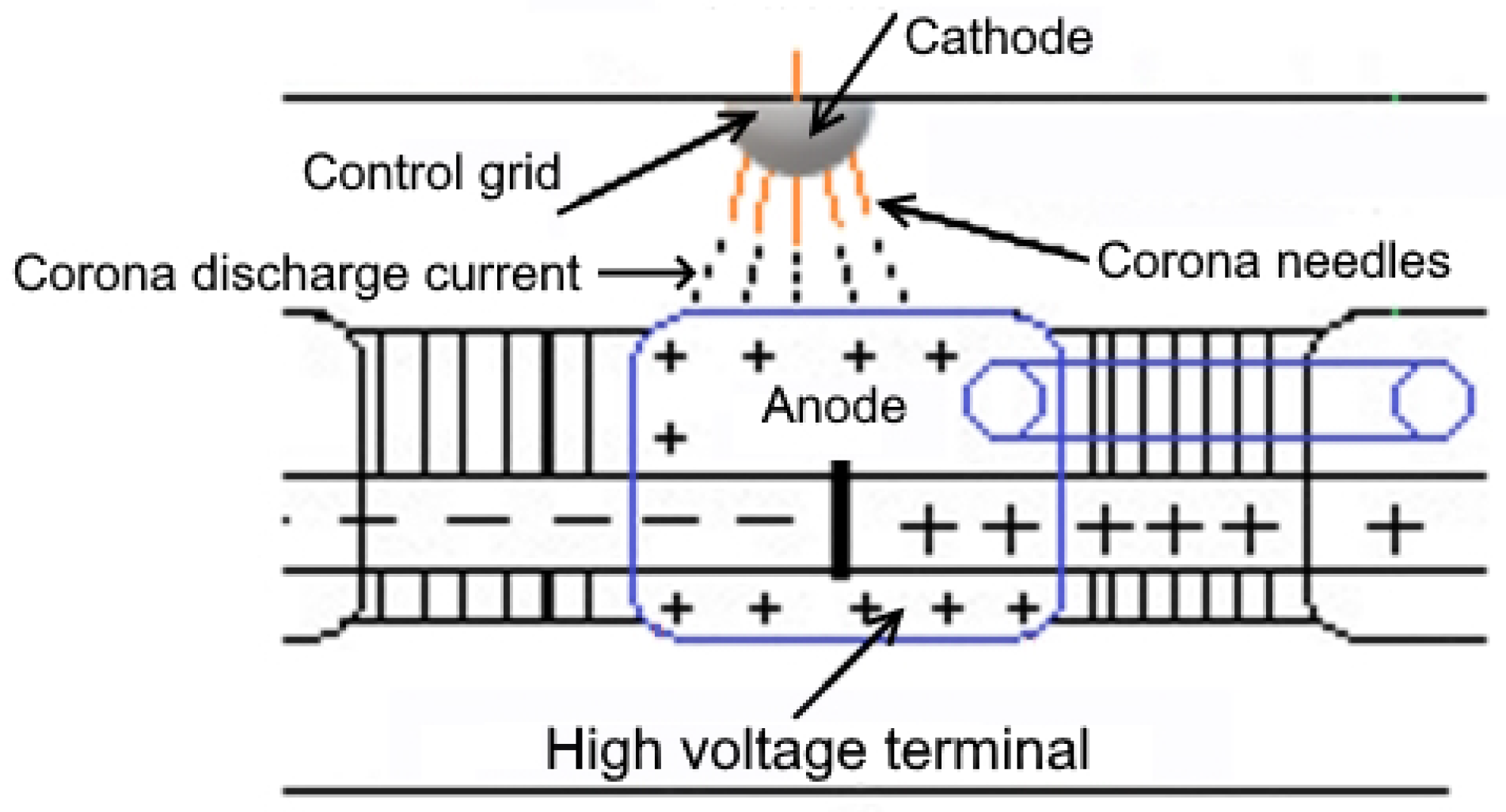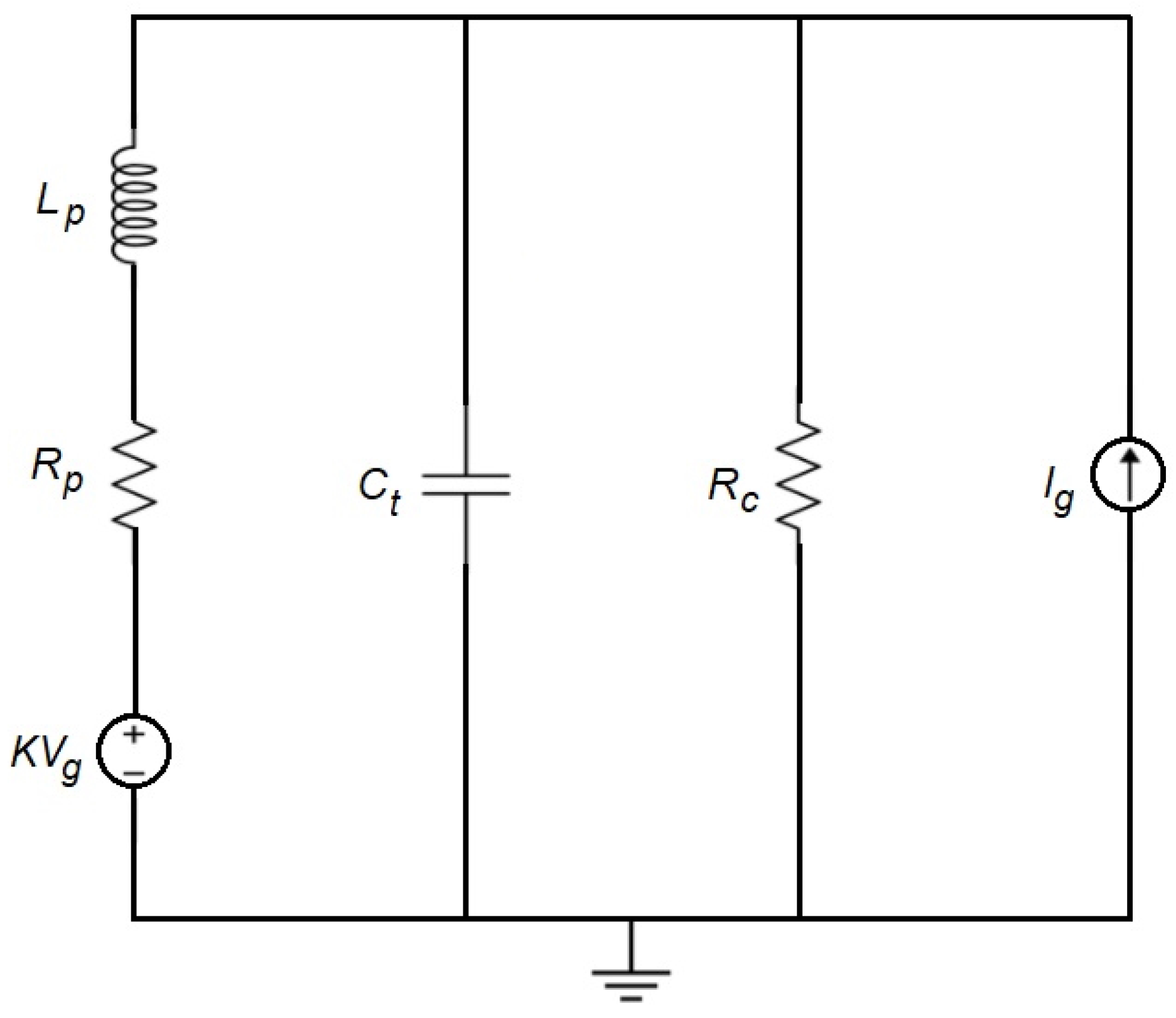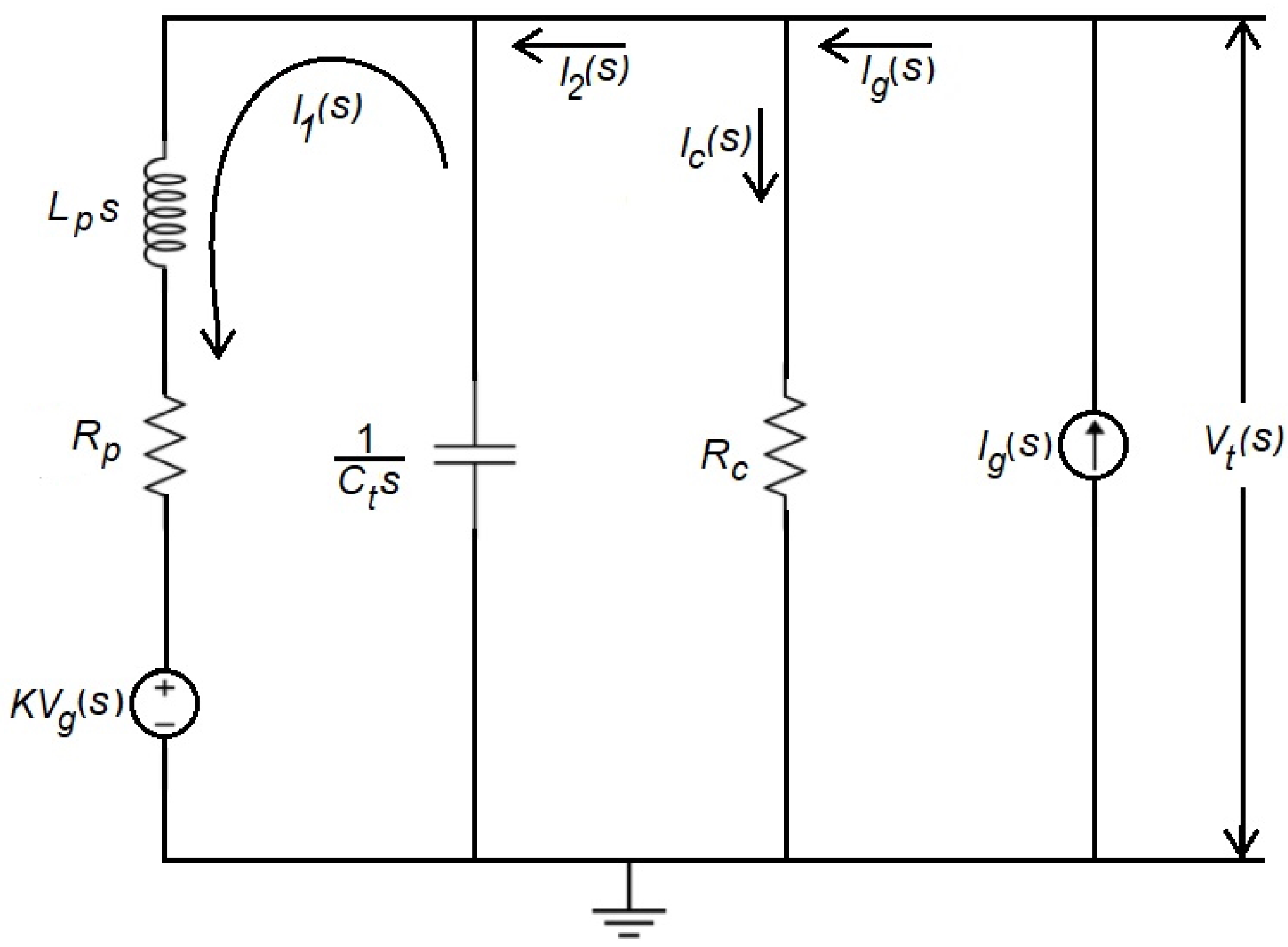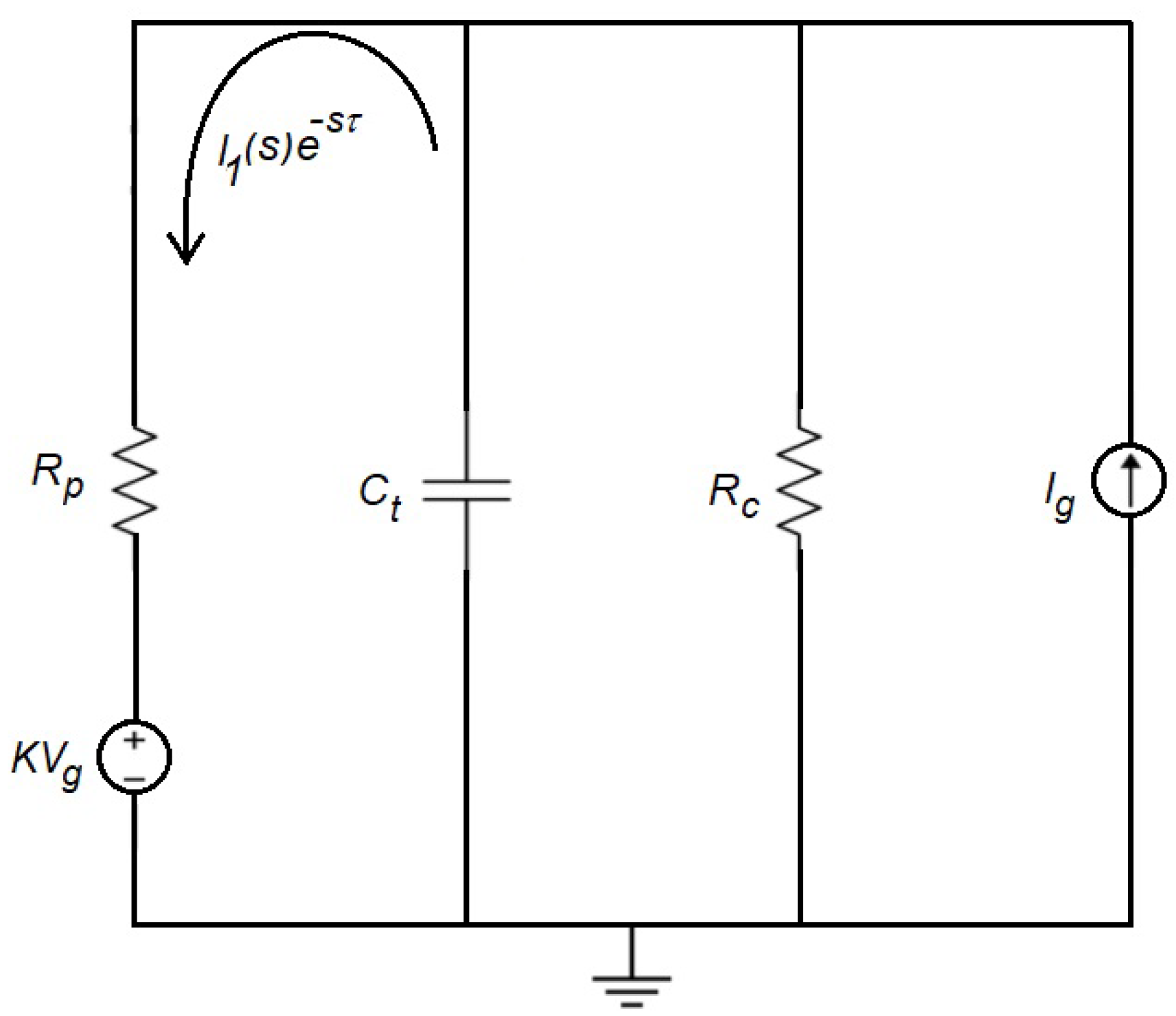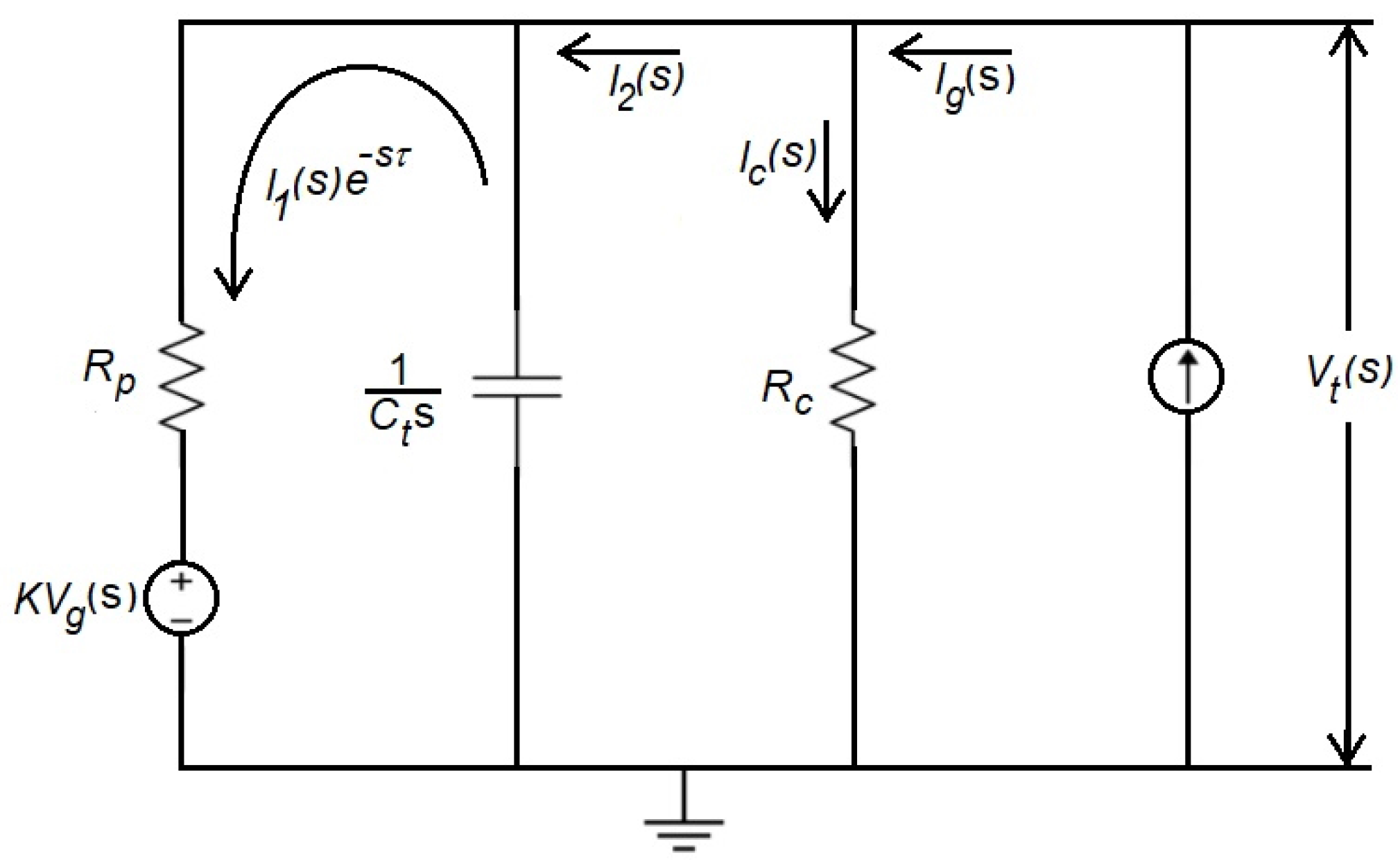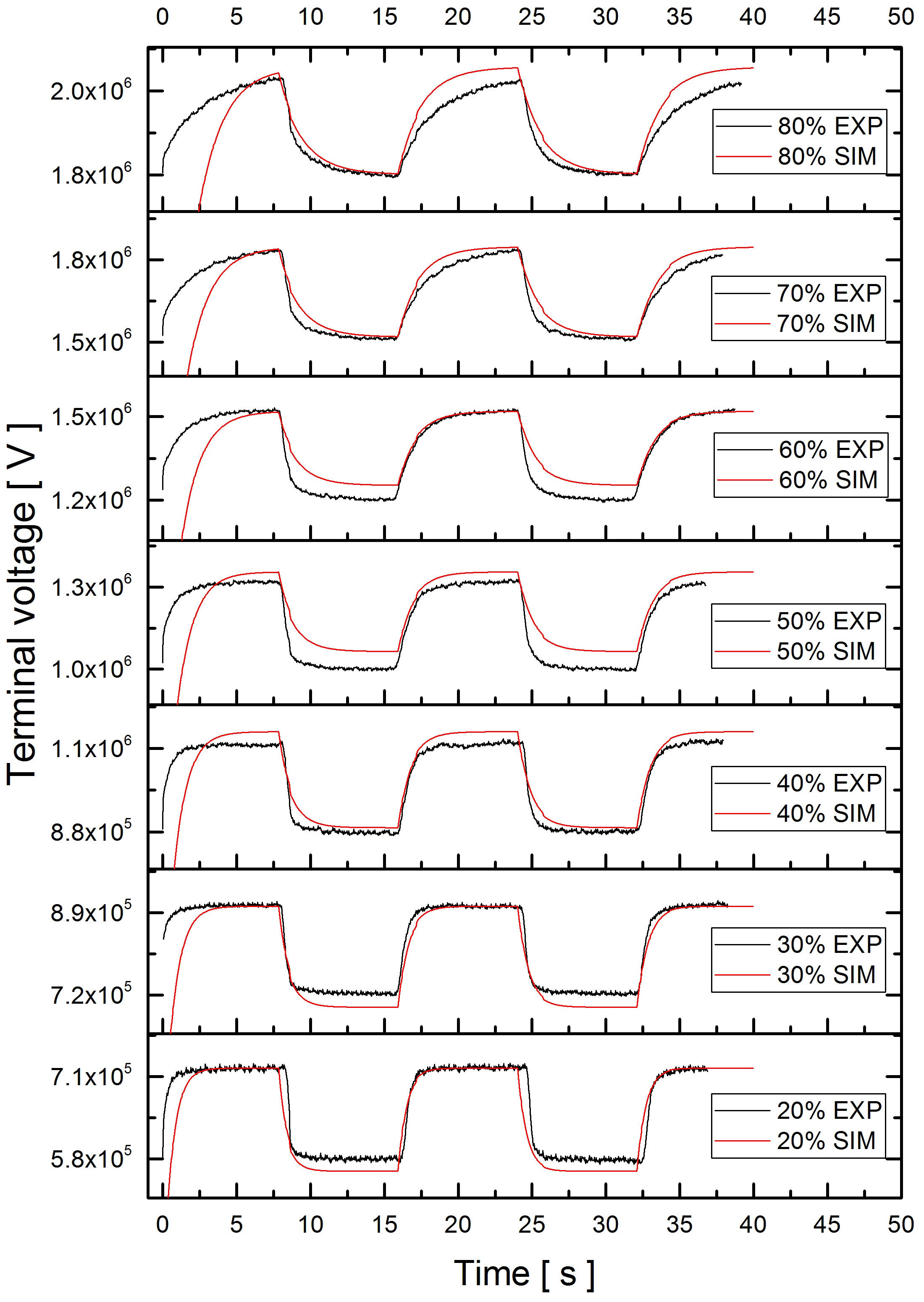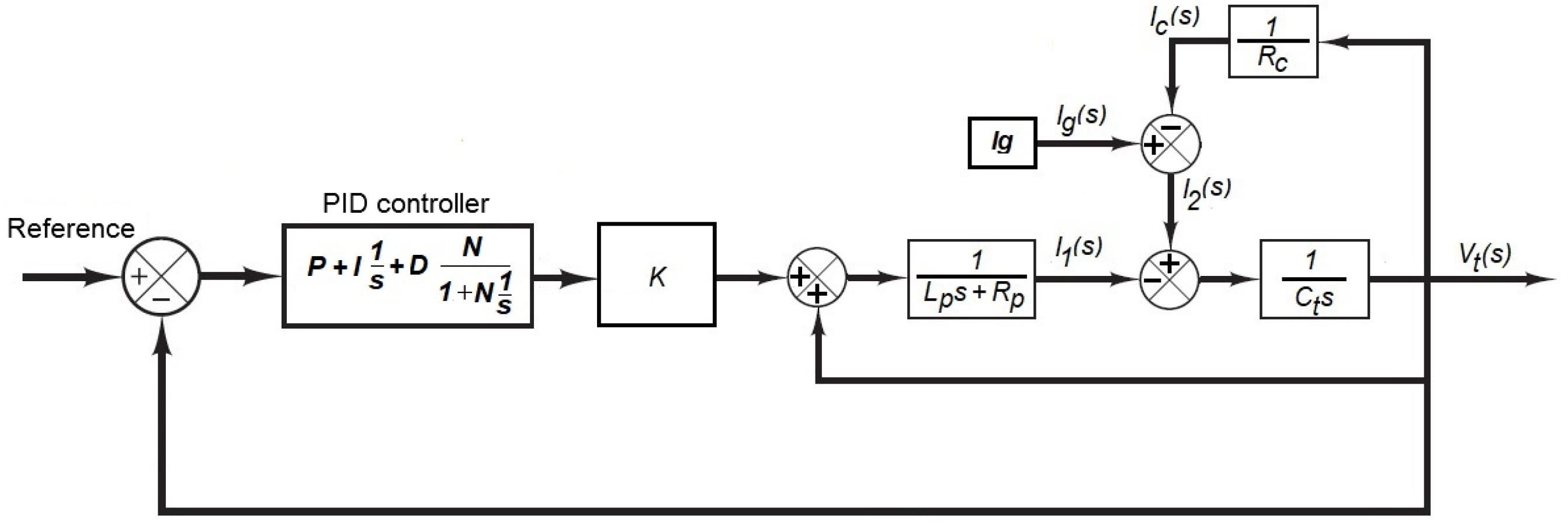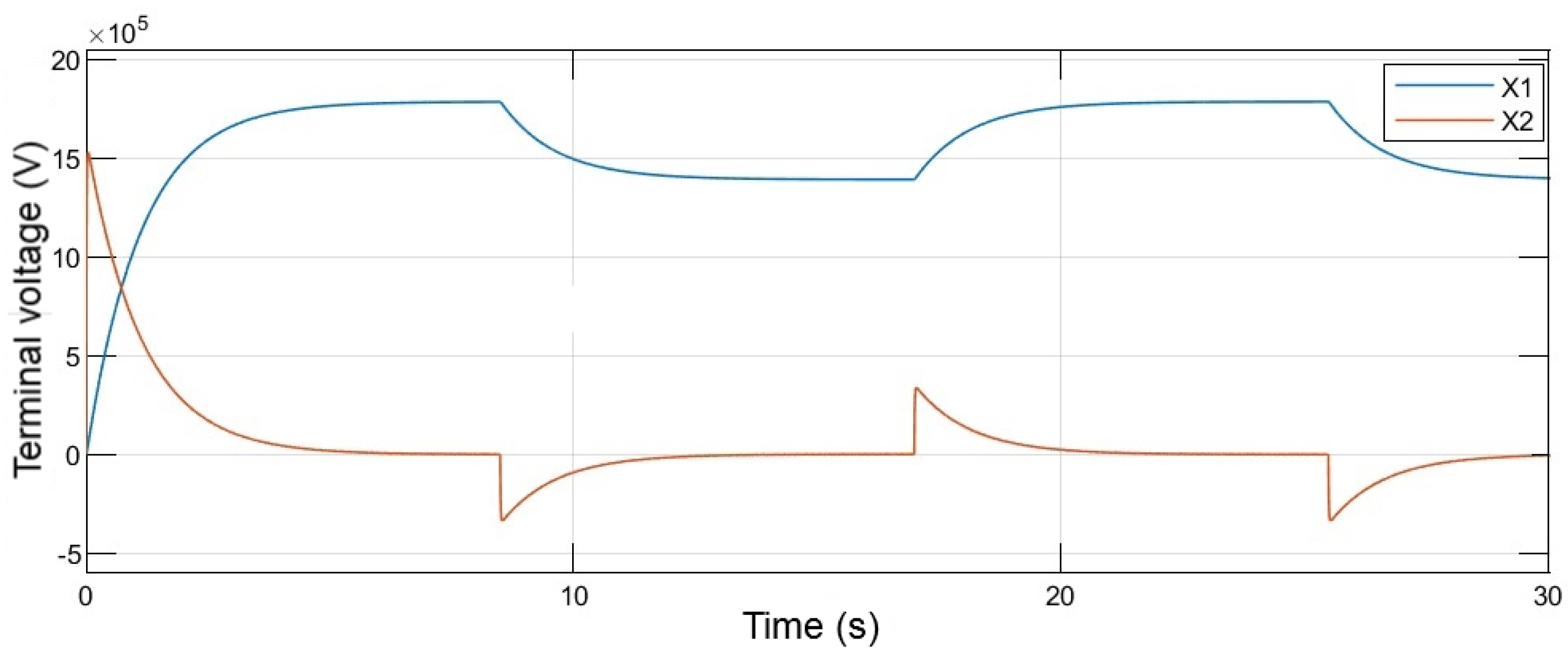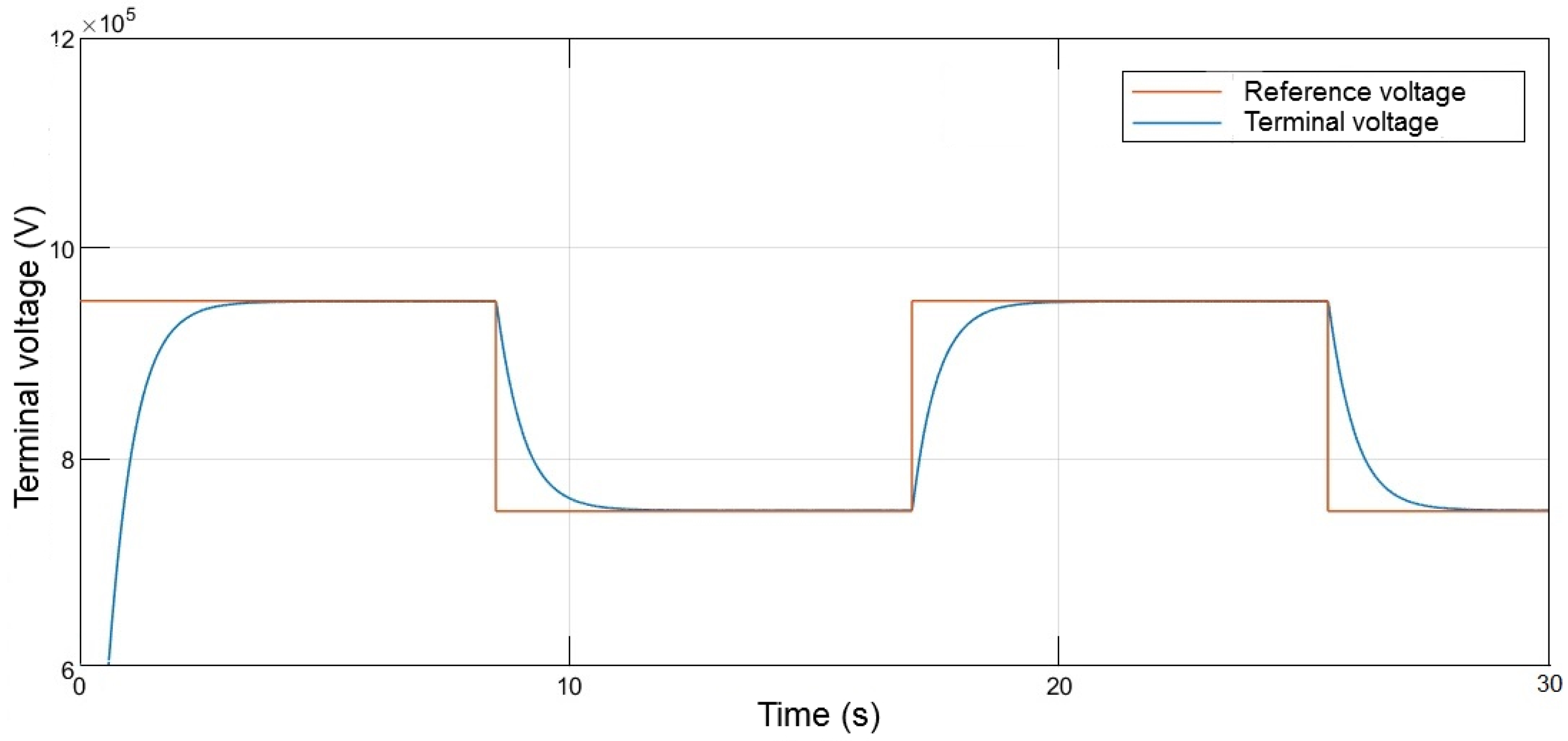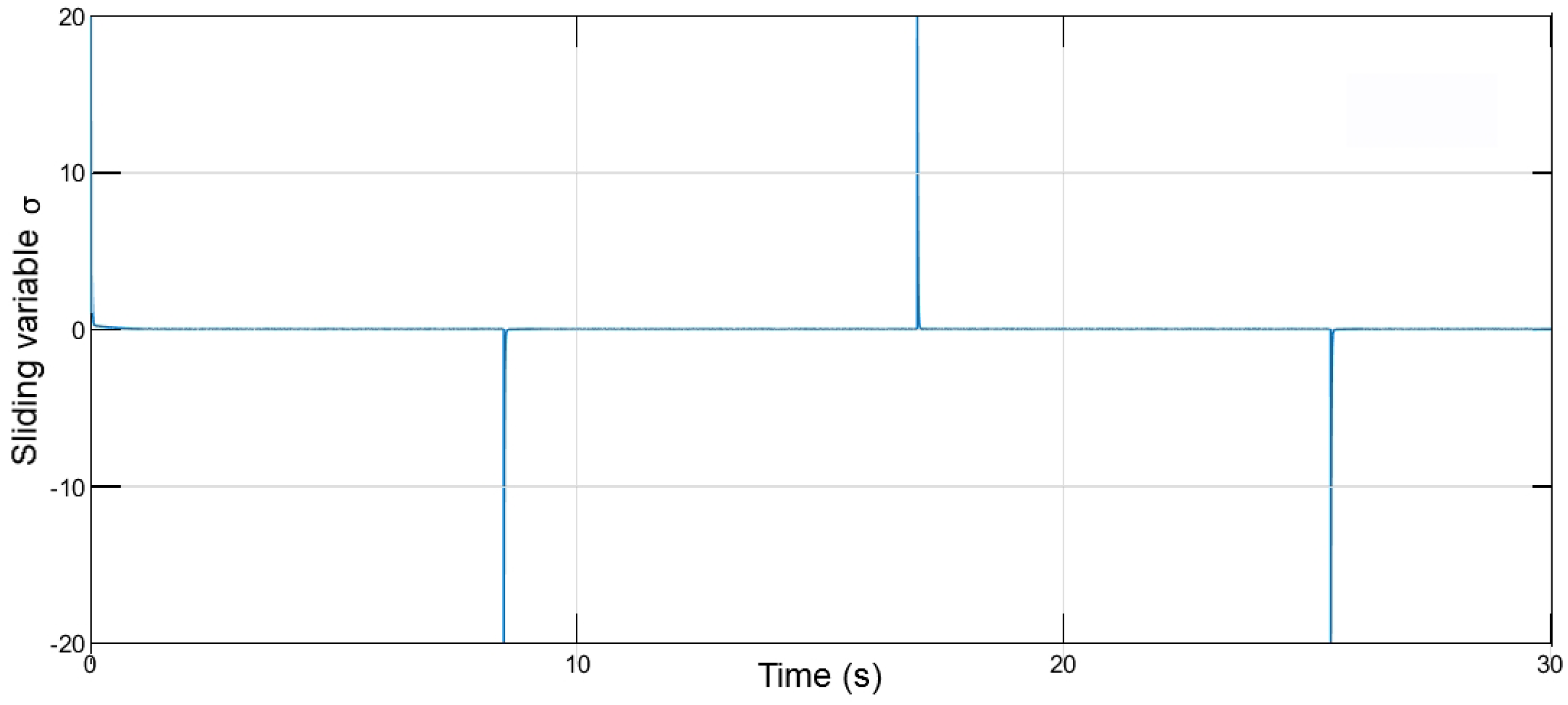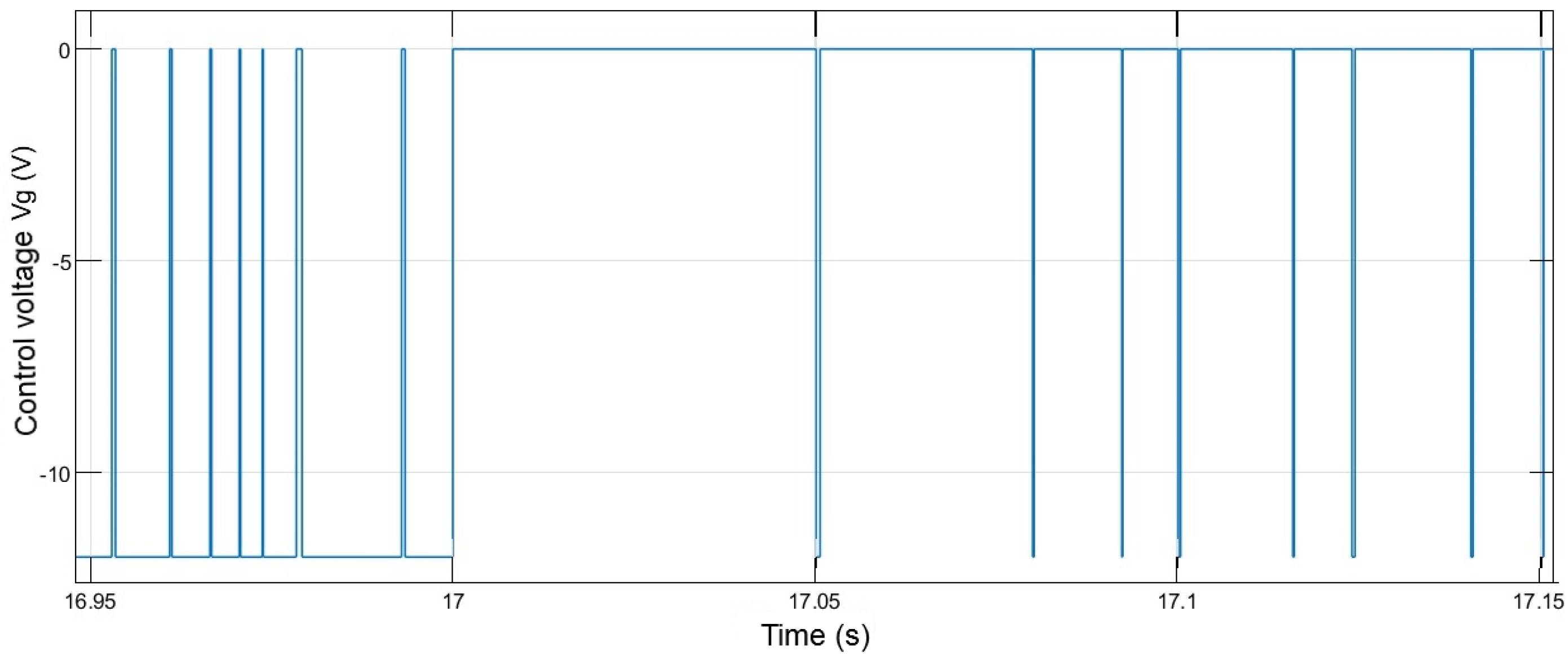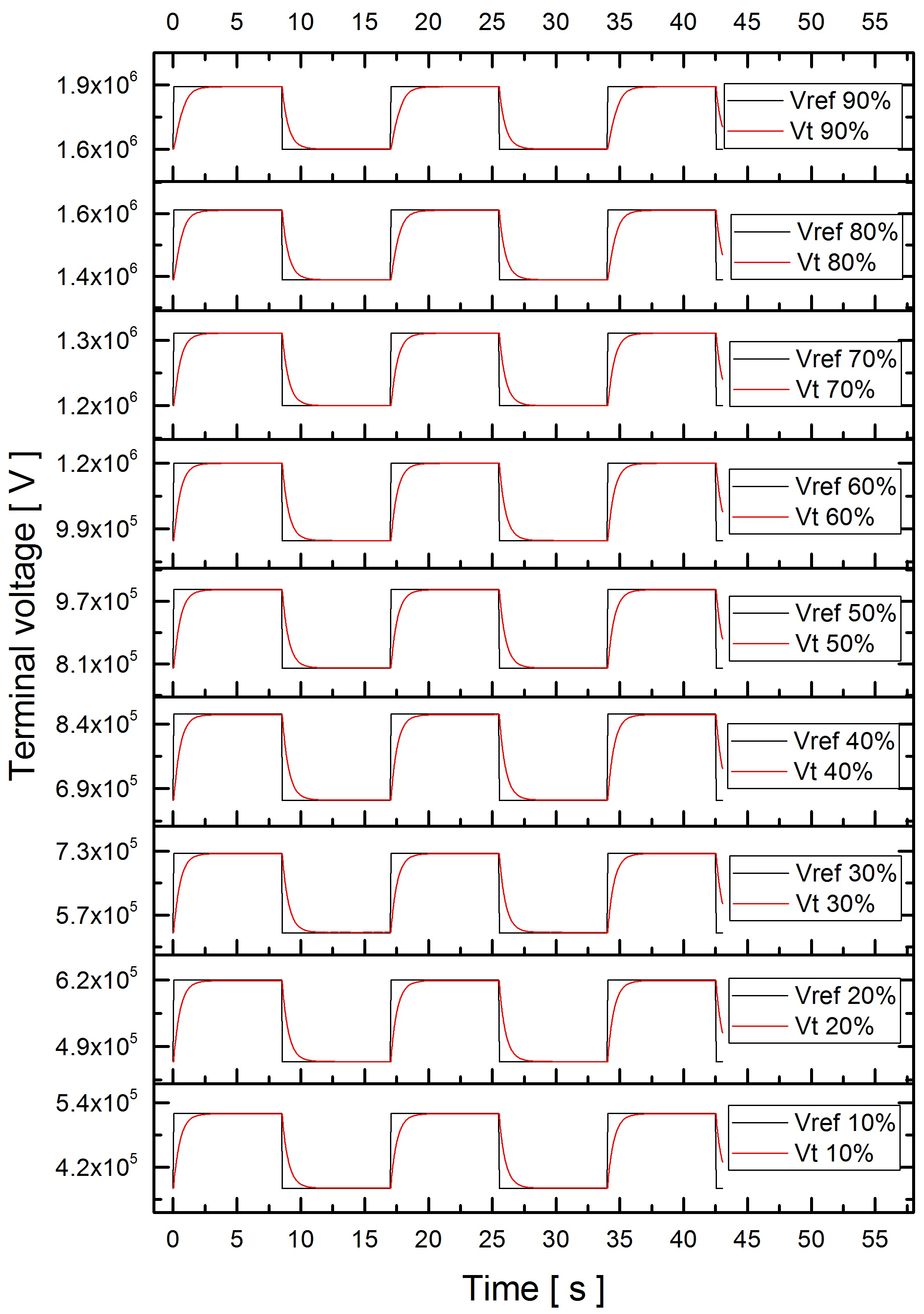As mentioned before, the transit time of the corona triode discharge current used to regulate the terminal voltage, hereinafter denoted by
, is a crucial aspect to be considered in the mathematical model of the system under study. The transit time of the corona triode is the time required by the charge carriers to cross the discharge path (see
Figure 3). This time depends on the cathode–anode distance, the inertia of the charge carriers, the dielectric gas used as an insulator, as well as the pressure of the gas. Both electrons and ions contribute to the charge transport, although the transit time for a positive potential at the terminal is determined primarily by the negative ions. Transit times of approximately 30 ms have been reported in the literature for accelerators of this type [
2,
3,
16].
The phase shift method is used to determine the transit time
. A low-frequency sinusoidal signal is put on the grid of the triode 6BK4. The phase shift
between the signal of the pick-up amplifier and the signal on the anode of the 6BK4 is measured using an oscilloscope. From the measured phase shift
, the transit-time is calculated as [
16]:
where
and
f is the frequency in Hertz. The
subtracted from the measured phase shift
corresponds to the contribution to the phase shift due to the terminal capacitance
. From Equations (
1) and (
2), transit times of 12 ms to 26 ms were obtained, for a distance between the corona needle and the terminal ranging from 20 to 80%.
Two different approaches were considered for describing the transit time of the corona discharge current. The first one considers an equivalent self-inductance in the corona triode. In the second one, the transit time is represented as a delay in the corona current.
3.1. Model Considering an Equivalent Self-Inductance of the Corona Triode
An electrical circuit representing the terminal of the tandem Van de Graaff accelerator [
16] is shown in
Figure 4. The circuit consists of a voltage source
representing the corona triode in series with the control triode, that is the vacuum valve 6BK4 (Radio Corporation of America (RCA), Harrison, NJ, USA), and a dimensionless amplification factor
K, which is defined as the product of the amplification factor of both triodes. The internal resistance
and the equivalent Self-Inductance of the Corona Triode (SICT)
are in series with this source. The terminal capacitance
and the column resistance
make up the external load of this circuit. The terminal charge current is represented by the current source
.
The electrical circuit shown in
Figure 4 is represented in the frequency domain, as shown in
Figure 5. This representation allows obtaining the mathematical model of the accelerator that relates the voltage at the terminal
as a function of the load current
and the control voltage
, which are the inputs of the system.
This model is derived as follows. From the circuit shown in
Figure 5, the equations that describe the dynamic behavior of the system are obtained by assuming initial conditions equal to zero. The voltage at the terminal
is given by:
From Equation (
3), it can be observed that the output voltage
is a function of the currents
and
, which are, respectively, the load and discharge currents of the capacitor
, which represents the terminal. These currents are given by:
and
where
is the current provided by the terminal charge source and
is the column current obtained from Equation (
6).
To obtain the voltage at the terminal
as a function of the inputs defined by the voltage source
and the load current source
, the superposition principle is applied. The system response is computed individually for each input, and then, the responses are added. The transfer function relating the voltage output
to the voltage input
(considering
equal to zero) is shown in Equation (
7).
The transfer function relating the voltage output
to the load current input from the terminal
(considering the voltage input
equal to zero) is given by Equation (
8).
The voltage at the terminal
as a function of voltage
and current
is described by Equation (
9).
The inductance
, the resistance
, and the amplification factor
K change with respect to the terminal position of the corona needles. This distance is expressed as a percentage: when the corona tips are at the closest point to the terminal, this percentage is zero, and when they are at the farthest point from the terminal, it is 100%. The numerical values of these elements were calculated experimentally, according to the procedure presented in [
3,
16], and they are shown in
Table 1. The capacitance
F and the resistance
are considered constant for any position of the corona needles.
Numerical simulations of the proposed model were performed using Matlab® R2020a –Simulink. For the simulations, it was considered that the corona needles are 70% away from the terminal. Typical values for the accelerator operation were considered for the input signals, i.e., current A. For the control voltage , a square signal taking values from 0 to V, and a period of 17 s was considered.
Figure 6 shows the simulation outcomes of the system described by Equation (
9). The red curve shows the voltage at the terminal
; the black curve shows the voltage generated by the current
; the blue one shows the potential generated by the input voltage
. It is observed that the sum of the input current
and the control voltage
contributes to generating the terminal voltage.
To validate the proposed model, experimental tests were conducted in the tandem Van de Graaff accelerator at the National Institute of Nuclear Research of Mexico. This accelerator has the following main characteristics: It is manufactured by the company High Voltage Engineering Corporation (Burlington, MA, USA). It has an accelerator tank with a 6 MV high-voltage band-type generator. It is a Source of Negative Ions by Cesium Sputtering (SNICS).
Figure 7 compares the voltage
obtained through simulations of the terminal model (Sim) with the experimental results (Exp) obtained in the tandem Van de Graaff accelerator. The corona needles move away from the terminal in a percentage ranging from 20 to 80% of the total distance. The terminal voltage was measured using the generating voltmeter by connecting a Tektronix
® digital oscilloscope model MSO2014B (Tektronix Inc., Shanghai, China) to this sensor.
In
Figure 7, the red and black curves, representing the simulation and experiment results, respectively, are remarkably close. This close alignment instills confidence in the accuracy and reliability of our proposed model, reinforcing its potential to reproduce the behavior of the terminal voltage. Note that, at the beginning of the simulation (
s), a significant discrepancy between the simulation and experimental results can be observed because the simulation was initialized considering zero initial conditions, placing the system in a transient regime, whereas the experimental data were collected during steady-state conditions of the accelerator. Note also that, at
s, there was a delay in the simulated response, primarily due to the effect of the inductance
in the model. The inductance opposes current changes, causing a delay in the response. Now, for the sake of comparison, we adapted the model by considering that the corona’s current transit time is represented by a delay, instead of the equivalent SICT.
3.2. Model Considering a Delay to Represent the Transit of the Current through the Corona Triode
The mathematical model of the terminal of the tandem Van de Graaff accelerator that considers a delay
corresponding to the transit time of the current through the corona triode (described in
Section 3) is determined from the electrical circuit shown in
Figure 8. The circuit elements
,
K,
,
,
, and
are the ones described in
Section 3.1.
The equivalent electrical circuit in the frequency domain that describes the accelerator operation is shown in
Figure 9. The mathematical model of the accelerator terminal behavior is obtained by defining the expression that relates the voltage
at the terminal as a function of the charge current
and the control voltage
.
From the circuit in
Figure 9, we obtain the equations describing the dynamic behavior of the system assuming initial conditions equal to zero. The voltage at the terminal
is given by Equation (
10).
It is observed that Equation (
10) is similar to Equation (
3) only with the corresponding time delay
in the current
. The currents
and
are defined in (
11) and (
12), respectively.
where
is the current provided by the terminal charge source and
is the column current obtained from Equation (
13).
By applying the superposition principle, we obtain the voltage at the terminal
as a function of the inputs defined by the voltage source
and the load current source
. The transfer function that relates the voltage output
to the voltage input
(considering
equals zero) is given by Equation (
14).
To obtain the transfer function relating the voltage output
to the load current input
of the terminal, the voltage input
is considered equal to zero, resulting in Equation (
15).
The voltage at the terminal
as a function of voltage
and current
is shown in Equation (
16).
As before, numerical simulations and experimental tests were conducted to assess the reliability of this model.
Regarding the terminal voltage
,
Figure 10 compares the simulation results (red curve) and the experimental outcomes (black curve) when the corona needles move away from the terminal potential by a percentage ranging from 20 to 80% of the total distance. Note that there is a significant discrepancy observed near
s, attributable to the same scenario described in
Section 3.1 for the SICT model.
Table 2 shows the Root-Mean-Squared Error (RMSE) calculation of the simulation of the two models concerning the experimental data when the corona needles move away from the terminal by a percentage ranging from 20 to 80%. The RMSE measures the square root of the average of the squared deviations between two signals that highly discriminate their differences. An RMSE equal to zero (optimum value) occurs when the signals are identical; the smaller the value, the greater the similarity is. The RMSE is an approximation of the error’s standard deviation. The RMSE has the same units as the signals being analyzed, making it an intuitive metric for understanding the discrepancy between signals [
17].
Note that the calculated RMSE is lower for the SICT model than the delayed model when the corona needles are separated by a distance between 20% and 80%. This indicates that the SICT model exhibits a closer resemblance to the actual behavior of the terminal than the delayed model.
With the proposed models, it was possible to reproduce the behavior of the terminal voltage of a real tandem Van de Graaff accelerator; the obtained results are similar to the results reported in other works (see, for example, Refs. [
7,
18]). From the data presented in
Figure 7 and
Figure 10, we can conclude that the voltages obtained using the model that takes into account the SICT have similar behavior to the one of the real accelerator terminal in the whole variation range of the corona needles’ distance. In contrast, the model that considers the transit time
has noticeable deviations when the corona tips are at 50, 60, and 80%.
Based on the model that considers the equivalent SICT, two different control strategies for regulating the accelerator’s terminal voltage were examined: PID controller and SMC.
